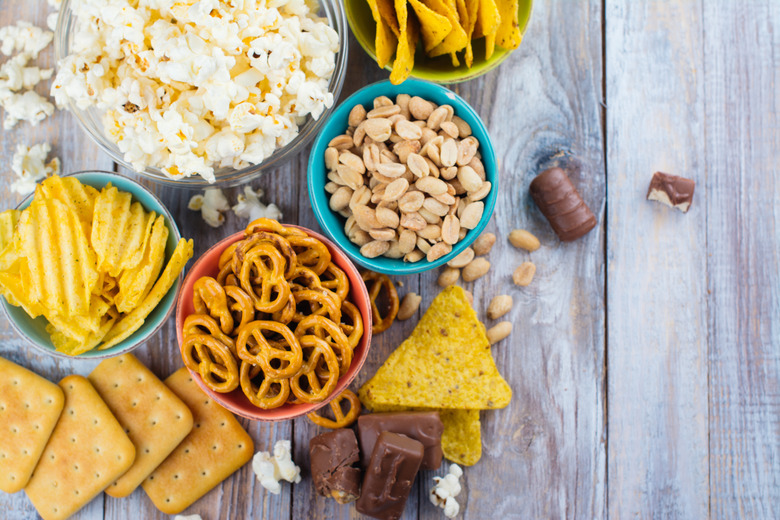What Chemical Compounds Are Thought To Be Responsible For The Tastes Of Bitter, Sour, Salty & Sweet?
When you eat a candy bar instead of a pickle, your taste buds notice the difference. Your tongue has bumps or papillae, that have taste buds to help you tell the difference between different foods. Each taste bud has many receptor cells that can recognize a variety of tastes. Chemical compounds that are responsible for bitter, sour, salty and sweet tastes can bind to these receptors. Read on to learn more about these chemical compounds and taste receptors.
TL;DR (Too Long; Didn't Read)
Receptors in your taste buds are responsible for you being able to tell apart bitter, sour, salty or sweet food. These receptors react to chemical compounds such as sulfamides, alkaloids, glucose, fructose, ionized salts, acids and glutamate.
Bitter Taste Receptors
Bitter Taste Receptors
Bitter taste may have evolved to protect us from poisons. Many alkaloids, which usually are toxic, elicit a bitter taste. Chemical compounds, such as quinine, produce a bitter taste by binding taste bud receptors that couple to G-proteins. G-protein activation initiates a signaling cascade that produces the sensation of bitterness.
Individuals possess 40 to 80 types of bitter taste receptors that detect a variety of substances, including sulfamides such as saccharin, urea and alkaloids, including quinine and caffeine. Children have more taste receptors than adults, and the number of taste receptors declines with age. In addition, children often dislike vegetables, which may be due to the production of bitter compounds by plants to protect themselves from animals who eat them. Sensitivity to bitter compounds is also dependent on genes that code for bitter taste receptors. Variations in these genes prevent some people from detecting bitterness in some compounds.
Sour Taste Receptors
Sour Taste Receptors
Sour taste comes from acidic foods. The acids in food liberate hydrogen ions or protons. The concentration of hydrogen ions determines the degree of sourness. Decomposition of food by bacteria produces acid or hydrogen ions, and while some fermented foods such as yogurt have a pleasant sourness, extreme sourness can be a warning sign of bacterial contamination of food. Hydrogen ions bind to acid-sensing channels in the membranes of taste cells. When channels become activated, they cause nerves to signal. Previously, researchers though that sour taste was mainly produced by hydrogen ions blocking potassium channels, but recent research identifies an acid-sensing cation channel as a main transducer of sour taste.
Salty Taste Receptors
Salty Taste Receptors
Humans often crave saltiness because sodium ions are necessary for many bodily functions. Saltiness in food is primarily derived from sodium chloride or table salt. A pleasant salty taste happens when sodium ions enter a sodium channel on the surface of taste cells and mediate nerve impulses via a calcium influx. A hormone, called aldosterone, increases the number of sodium channels on taste cells when there is a deficiency of sodium. Sodium channels on taste cells are also sensitive to the chemical amiloride and differ from sodium channels on nerve and muscle.
Sweet Taste Receptors
Sweet Taste Receptors
The body's preference for sweet taste may be due to the ability of sweet foods to provide a quick source of energy. The sweet taste in food comes mostly from glucose and fructose, which are in sucrose, or sugar. However, a sweet taste can also come from non-carbohydrates, such as aspartame, saccharin and certain proteins. Sweet substances, just like bitter substances, bind to G-protein-coupled receptors, leading to nerve activation.
Other Tastes to Know
Other Tastes to Know
Taste buds can also detect certain amino acids in proteins. This is the savory or umami taste. Protein-derived amino acids, such as glutamate and aspartate, and salts of glutamic acid, such as monosodium glutamate, which is popular in Asian dishes, bind to G-protein-coupled receptors. The receptor interaction activates ion channels and generates a signaling cascade similar to the ones that come from bitter and sweet compounds.
The basic taste categories and signaling mechanisms for bitter, sour, salty, sweet and umami are well-established and researched. However, the understanding of tastes for metallic and fatty substances is far from complete.
Cite This Article
MLA
Blue, Marie-Luise. "What Chemical Compounds Are Thought To Be Responsible For The Tastes Of Bitter, Sour, Salty & Sweet?" sciencing.com, https://www.sciencing.com/chemical-compounds-thought-responsible-tastes-bitter-sour-salty-sweet-16579/. 27 April 2018.
APA
Blue, Marie-Luise. (2018, April 27). What Chemical Compounds Are Thought To Be Responsible For The Tastes Of Bitter, Sour, Salty & Sweet?. sciencing.com. Retrieved from https://www.sciencing.com/chemical-compounds-thought-responsible-tastes-bitter-sour-salty-sweet-16579/
Chicago
Blue, Marie-Luise. What Chemical Compounds Are Thought To Be Responsible For The Tastes Of Bitter, Sour, Salty & Sweet? last modified August 30, 2022. https://www.sciencing.com/chemical-compounds-thought-responsible-tastes-bitter-sour-salty-sweet-16579/
